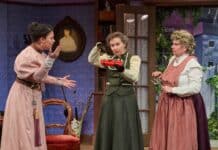The Russians are singing, the Russians are singing! And they are connecting — or at least they’re trying to. Can people find each other in times of trial? Natasha, Pierre & the Great Comet of 1812 works to answer these questions and does so with one of the most engaging musical theater scores of the last decade.
A few years ago, if anyone had put down Leo Tolstoy’s War and Peace for musical adaptation — or at least one section of it — some might have thought perhaps it was destined for a grand opera house, being such a sweeping novel. But a sung-through, pop-opera musical might not have been on our bingo card. How lucky we are that George Mason University’s School of Theater decided to produce the show, helmed by James Gardiner, in a production that solidifies its place among innovative musicals.

The creation of multi-hyphenate Dave Malloy — composer, musician, playwright, orchestrator — the musical is an adaptation of a 70-page section from Tolstoy’s tome, focusing on a love triangle and a search for deeper meaning in life. The still-raging War of 1812 and the impending appearance of the Great Comet both percolate in the background.
As the title implies, the story is focused on several characters, starting with Pierre Bezukhov, a brooder in an unhappy marriage to Helene. Pierre connects several characters as both a friend and a relative. Brett Womack played Pierre, and he was a commanding presence from start to finish, possessing a mellifluous baritone and heart-wrenching acting chops. Among Womack’s multiple vocal highlights were the soul-bearing “Dust and Ashes” and the luscious duet with Natasha, “Pierre and Natasha.” As written, Pierre is the central figure, and Womack had the gravitas to remain a focal point for the story.
As the other title role, Jennah Sidiabed as Natasha was a dynamic performer who brought the character’s complexities to the forefront. Natasha is betrothed to the regal Andrey, who is off at the big war’s front line. She moves to Moscow with her cousin Sonya to live with her godmother, Marya. Natasha’s life is turned upside down when handsome and charismatic Anatole is smitten with her and uses his rakish charm to woo her, and she falls hard. Sidiabed skillfully balances the wide-eyed innocence and the growing passion in Natasha, and her voice was expressive and powerful when she rendered “No One Else,” a sumptuous, romantic aria.
As the cad Anatole, the aptly named Spencer Wilde cut a dashing figure — flamboyant and sexy, with long rock-star hair and swagger to spare. His scenes with Sidiabed crackled with chemistry.
Other stunning vocalists among the cast members included Katie Rowe, as Natasha’s cousin Sonya. Rowe showed the devotion of a best friend and committed family member and the hurt she feels toward her mixed-up cousin. In “Sonya Alone,” her second act solo turn, Rowe’s voice filled the theater with heartbreak. As Pierre’s saucy and unfaithful wife, Helene, Brea Davis used her winning smile and flashing eyes to show the seductive and playful character to her best advantage. Davis’s belting voice made a meal out of “Charming,” in which she celebrates the scandalous affair between Natasha and her brother Anatole, a married man.

Serving as a mother figure for Natasha and Sonya, Marya, the “old school, grand dame of Moscow,” attempts to provide stability to the transplanted young ladies. Shannon Harel played Marya with grace and authority. As another Muscovite cad, Dolokhov, Elise LeGault matched Wilde’s Anatole with hedonistic verve.
Rounding out the cast, filling out, as the show says, “minor characters,” Kai Yoffe was a memorable old prince, Ky Dermott played “plain” Mary, and Ashton Mattos nearly stole his scene as the wild and crazy troika driver Balaga — think Jack Black.
The main characters were clearly up to the task of this challenging show, but so was the versatile ensemble, who rarely left the stage, playing all sorts of citizens, party-goers, and figures throughout the story. These performers handled the eclectic choreography by Ariel Kraje with style and commitment, handling everything from lyrical dance to ballroom and folk dancing. Members of the ensemble included Aurora Powell, Emma Harris, Jalen Whitmore, Sophia Ferolito, Elias Collier, Owen Potts, Nicholas Koch, Dae-Quon Shines, Gianna Battaglia, and Kaya Thomas (as swing).
Director James Gardiner, whom readers may know from his long career as a local actor and staff member at Arlington’s Signature Theatre, used his talented cast and the stage space to most advantage, creating engaging tableaux throughout, and employing the aforementioned Kraje’s choreography to propel the story forward. Special mention must be made to Gardiner and Kraje’s work with the entire cast on the stunning opening “Prologue” in which the characters — “everyone’s got nine different names” — are introduced and the story is teased out.
Joe Walsh‘s musical direction was impeccable, giving the production the polish to showcase Malloy’s delightful score. Gardiner was also blessed with the collaborations of Jonathan Dahm Robinson, Channing Tucker, and Mary Clare Bernier — scenic, costume, and lighting designers, respectively. Robinson’s stage design used nearly every inch of the Harris Theatre’s stage; multi-level platforms and entrances all around allowed for fluid movement by actors and a fertile ground for the cinematic presentation to come to life. And the huge stage was illuminated by a kaleidoscopic array of lighting that helped isolate soloists and expand the scope of the staging creatively. Colorful, wild, and bold, Tucker’s costume design palette gilded the actors in decadence on a fitting operatic scale.
To have universities like George Mason close by expands the theatrical offerings area audiences can experience. If Natasha, Pierre by the Mason School of Theater is any indication of quality, you owe it to yourself to check out their season now and forever.
Running Time: Approximately two hours with one 10-minute intermission.
Natasha, Pierre & The Great Comet of 1812 played October 30 through November 2, 2025, presented by George Mason School of Theater, performing at the Harris Theatre on the George Mason University campus, 4471 Aquia Creek Lane, Fairfax, VA.
The program for Natasha, Pierre & The Great Comet of 1812 is online here.
Natasha, Pierre & The Great Comet of 1812
Written by Dave Malloy
Directed by James Gardiner
Musical Direction by Joe Walsh
Choreography by Ariel Kraje



